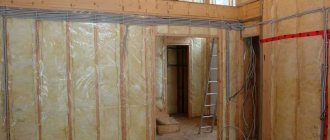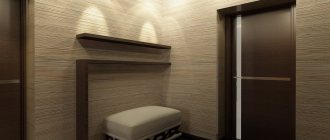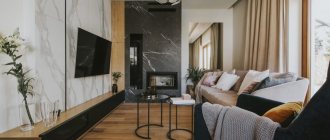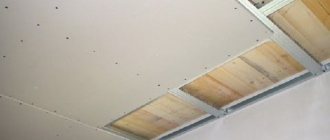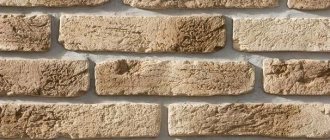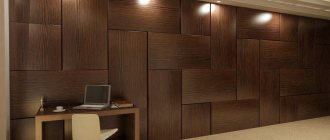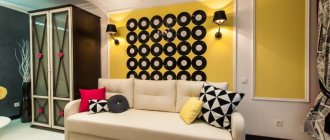Pros and cons of drywall
Like any material, drywall has its significant advantages, as well as disadvantages.
The main advantages of drywall for finishing work in the living room:
- The material is easy to cut, which allows you to create various shapes of the structure;
- Does not require professional skills for installation;
- Budget cost and availability, sold in every hardware store;
- Easily lends itself to various materials that can be used to create decoration;
- With the help of drywall you can hide unevenness and various defects of the wall, ceiling, and also hide wires;
- You can make original multi-tiered structures from it;
- With proper care and careful use, drywall is a durable material.
There are also several disadvantages that should be taken into account when deciding to decorate a room with plasterboard:
- If the room has low ceilings, then you should not use this material, as it will lower them by another 10-15 cm;
- Drywall is not suitable for finishing if the building has just been built, as a crack may form;
- If improperly maintained or used, this material may become deformed and lose its original appearance.
Plasterboard niche for TV in the living room
It is almost impossible to imagine a modern living room without a large TV. Even strict opponents of television do not deny themselves the pleasure of showing their favorite films or clips on the screen.
But finding a comfortable place even in a spacious living room is not always easy, because you still need to fit a sofa, table, cabinets, work area, shelves and books, musical instruments and a lot of other little things. Therefore, modern ergonomic designs come to the fore.
Plasterboard niches can easily replace old, clumsy walls. They will also help you organize space correctly, because it is a powerful tool for visually zoning a room.
Using drywall in the living room
In the living room, drywall can be used in several ways, namely:
- To decorate the ceiling;
- Creating a box or niche;
- As a partition;
- Creation of shelves;
- Design of relief walls;
- For original decorative elements.
The most popular option is to design a plasterboard ceiling; it can be made either standard or multi-level with various decorative elements.
Drywall is also often used to create a niche or box with lighting, arches and various partitions for zoning a room.
Plasterboard ceilings in the living room interior
If you set out to remodel your living room using drywall, then ceilings will help in this matter. The simplest design can be single-level and even. For a living room in a modern style, this is an ideal design option. But still, if you want to achieve a completely different look for the room, you can make a rounded edging in the corners.
Decorative partition and plasterboard ceiling
Multi-level ceiling structures made of plasterboard are a completely new type of ceiling design. There are a huge number of curly options here. It’s now easy to create something unusual and original on the ceiling. It all depends on your imagination.
Figured arch made of plasterboard in the interior of the living room
For a plasterboard ceiling to become a real work of art, it must be properly lit. The modern lighting market offers a wide range of lamps. Each of them differs in shape, design, power and type of glow. As you can see, choosing lighting is not difficult.
We can talk about plasterboard, which is often used in interior design, for a long time. In order for the design to turn out correctly, where such structures will be used, it is important to place accents. You can make a niche, shelf or partition from plasterboard with your own hands. The main thing is to be patient and have the necessary tools.
Types of drywall for finishing the living room
It is worth noting that drywall is divided into several types, each of them has its own characteristic features and nuances. To make it easier to decide which drywall to purchase for decorating a living room, you should know the main types of this material and their brief characteristics:
- GKL slabs are standard gray plasterboard with blue markings. This type of material is suitable for dry rooms and has proven itself in the manufacture of partitions, suspended ceilings and for sound insulation. The thickness of plasterboard plasterboard is 8-16 mm, it does not contain any additives.
- Drywall GKLV - drywall is not afraid of high humidity and water. Available in green and blue markings. This type of plasterboard is well suited for covering walls, floors, and ceilings.
- GKLO slabs are gray plasterboard with red markings, which are not afraid of open fire, and contain glass fiber. It is worth noting that this type of drywall is practically not used in the design of an apartment or private house.
- Drywall GKLVO - painted green and with red markings. This type of material tolerates high humidity well and is not afraid of fire, so it is well suited for kitchen decoration.
Experts also identify several other types of drywall, but they are not so often used for repair purposes:
- Restoration;
- Laminated;
- Acoustic;
- Arched;
- Facade;
- X-ray protective drywall.
Ceiling in the living room made of plasterboard
Decorating the ceiling in the living room with plasterboard is an excellent option for a room that does not have low ceilings. You can make the ceiling standard, two-level or multi-level, depending on personal preferences and the height of the room and its design.
A standard one-level ceiling is an ideal solution for a small living room. This ceiling design option is suitable for both classic style and minimalism, loft.
A two-level plasterboard ceiling can be combined with a stretch fabric. It is worth considering that creating this type of ceiling requires quite complex installation and more time, in contrast to a standard one-level ceiling.
A multi-level ceiling is one of the most chic and interesting options, but it requires significant installation effort and is absolutely not suitable for a small living room.
Technology for creating plasterboard niches
GKL is a universal material used in finishing premises and constructing partitions. The surface created with its help is perfectly flat, ready for final finishing, after which the seams become invisible. A plasterboard wall in the living room can be found in almost every apartment that has undergone a major renovation. An additional advantage of the material is the ability to bend it, design arches, waves and install any other curved elements.
The process of creating a niche from gypsum plasterboard in the living room is divided into 4 stages:
- A profile is applied to the wall, holes are made through it using a hammer drill, into which dowels and screws are driven. The distance between the fastening elements is 40–50 cm. In this way, the outline of the future structure is collected.
USEFUL INFORMATION: Basics of leveling walls with plasterboard with a frame with your own hands (video)
- To give volume to the decorative element being built, cross members are installed along the entire perimeter of the product perpendicular to the wall. They are also fastened using self-tapping screws. If the height of the niche reaches the ceiling, the upper crossbars are attached to it, and the lower ones to the floor.
- The outer contour is formed along the edges of the crossbars. At the same stage, electrical wiring for spotlights is installed.
Make sure that the cables do not touch the profiles; it is better to hide them in corrugation or plastic boxes.
- The final stage of constructing a niche is lining it with plasterboard. Having carefully measured each of the sections, cut the sheets into pieces of a suitable size. Fix the slab fragments to the profiles using self-tapping screws. The distance between fastening elements is up to 20 cm.
After installation, the surface is puttyed and finished.
Relief walls in the living room
The relief walls in the living room look very original and fit with various style solutions. Walls of this type are decorated using plasterboard, because such a plastic material can be made into any shape.
For this work, it is recommended to use gypsum plasterboard. You can make the desired shape using a roller directly on a sheet of drywall or use decorative plaster. When finishing in this way, it is worth considering that special care will be required later.
Recommendations for decorating a living room with plasterboard
Experts give useful tips to make it easier and simpler to decorate a living room using drywall and get an original, beautiful design:
- If the walls are decorated with plasterboard of the gypsum board type, then it is best to combine them with fabrics such as tapestry, drape, chintz, silk or velvet; it is not recommended to use standard furniture fabric.
- In order to make it easier to give the drywall the desired shape, especially in the form of an arch, you should first soak the drywall with water, and then shape and fix it.
- If the wall is decorated with plasterboard and there is a desire to place paintings and panels on it, then it is recommended to strengthen the wall with additional profiles.
- If you are making a ceiling in the living room, which is located on the south side, then you can safely paint it in blue, gray or green tones.
- LED strip, spotlights and spots are some of the popular and more suitable lighting devices for plasterboard ceilings.
- A ceiling of 3 or more tiers is more appropriate for the living room of a large private house, where space and height allow.
- A patterned arch with lighting will not only be an excellent decorative element, but can also serve as room zoning.
- Only shaped plasterboard boards that are marked accordingly should be used.
Living room design using drywall
The decoration of the living room is always given special and close attention. There are a number of important reasons for this. Firstly, this room occupies a special place in every home. This is where all family members spend most of their free time.
Curved ceiling and plasterboard shelves in the living room interior
Secondly, this room exists to receive guests. This is the face of the owner of the house and a sign of his wealth and taste preferences. That’s why you need to find a special approach to creating an interior.
Built-in wall plasterboard shelves with lighting
It is important to give the living room not only an aesthetic appearance, but also to make it as functional as possible. It is plasterboard structures that will help make the interior unusual and original.
Decorative interior partition in the living room
But plasterboard structures must also be used with caution. There should be a sense of proportion in everything. This material is not always and not ideal everywhere. For example, you should not make living room furniture from plasterboard. It always occupies a central place in the room and should look accordingly. Here it is important to maintain coziness, convenience and aesthetic appearance in the furniture.
Two-level ceiling in the living room interior with lighting
But, for example, wall shelves or cabinets can be easily replaced with plasterboard niches and shelves. In some cases, this is the only option when it comes to small and cramped spaces.
Figured ceiling with plasterboard lighting
With the help of plasterboard structures you can visually expand the dimensions of the room. At the same time, the room will not look cluttered. Basically, all such designs are functional and save space. Also, one of the main advantages of the material is that everything can be done with your own hands without outside help. Let's take a closer look at what can be made from drywall and why.
Plasterboard ceilings can be combined with stretch fabric
